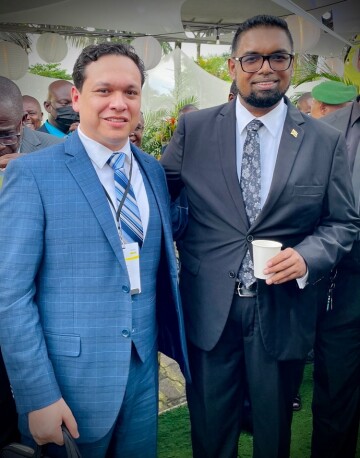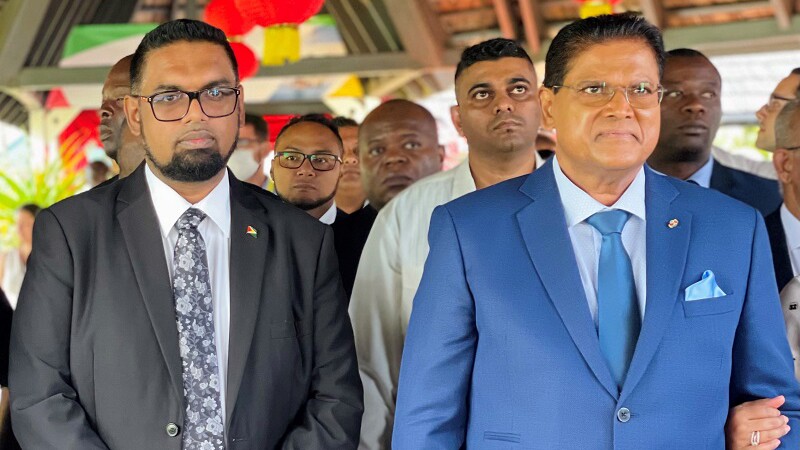Nations coming together with common interests and approaches to energy is a hallmark of the modern times: the EU aims to retire its fossil fuel dependency (in principle), and OPEC remains organized with its common focus on oil. However, nations in South America and the Caribbean are also joining the trend via strategic energy alliances as disclosed by the presidents of Guyana and Suriname, Irfaan Ali and Chan Santokhi, respectively. Ali said, “Suriname and Guyana stand on the cusp of major development … [and become] a new force in the world.”
This took place at the Suriname Energy, Oil & Gas Summit (SEOGS) event held 28–30 June in Suriname, Paramaribo, which I attended.
Such alliances would not only change the calculus of energy in the Western hemisphere, but it stands to have reverberations as the global energy map is being restructured, due to the Russian-Ukrainian conflict. The ongoing conflict has left Europe requiring alternate sources of oil and gas, which the South America and the Caribbean region can assist with.
Ali remarked that a strategy map of how a collective regional approach would unfold is to be released in the coming months. Pivotally, Guyana is emerging as a world-class basin for offshore oil output at Starbroek, in Guyana’s deepwater sector. Therefore, Suriname, as Guyana’s southern neighbor which shares similar offshore geology, has a template to follow. Moreover, additional offshore production capabilities were installed in Guyana by ExxonMobil in February.
By 2027, based on additional commitments announced by ExxonMobil, Guyana is poised to surpass 1 million BOPD threshold, placing it in the same realm as UK and US offshore production in a span of just 8 years.
Guyana started producing offshore oil in 2019 from Starbroek. Presently, Block 58—operated by TotalEnergies—which has a total of five discoveries, adjacent to Starbroek, is a catalyst for Suriname that can lead to its rising in a similar fashion to Guyana, as I previously outlined in 2020.
Critically, a deepwater development has not been sanctioned in Suriname, but this can change with Block 58, or a separate offshore development, being approved. It is noteworthy that the presidents of Suriname and Guyana expressed an approach that mirrored that of Equinor’s in Norway: the harnessing of prudent hydrocarbon production while augmenting renewable capabilities in a parallel manner.

The Swinging Energy Pendulum
How would the banding of nations look in South America and the Caribbean? This was outlined by Ali, who categorically expressed that Barbados, Trinidad and Tobago (T&T), with the inclusion of Guyana and Suriname, would protect their collective resources, with an eye toward energy security purposes. North Brazil was equally mentioned as an area to be included in the context of regional cooperation.
Separately, at SEOGS, T&T’s Energy Minister Stuart Young emphatically doubled down on regional banding, while he also expressed T&T’s operational willingness to share its experience in the hydrocarbon sectors with neighboring nations. After all, T&T is the most-experienced in the offshore sector as it pertains to the nations listed above (Brazil being an exception).
In his opening speech, Young referred to an article published in the Journal of Petroleum of Technology and remarked that coal—the most CO2-intensive primary energy—is once more being pursued despite net-zero pledges as an energy-security measure, commenting on the "rhetoric vs. reality" maneuvering that is occurring in Europe. For this reason, he noted that gas, which is the least CO2-intensive primary energy, is a transitional fuel, which echoes Daniel Yergin’s thesis on gas from 2020.
Young evidenced a strategy for the region which aligns with a broader view on energy and sustainability, much like Guyana and Suriname’s presidents (reference the Equinor example above).
It is vital to highlight that as the conference was taking place, Suriname and T&T’s “state-owned energy companies” signed a Memorandum of Understanding (from the sidelines) for cooperation and development amongst them, in which Young directly participated.
Importantly, T&T also has an infrastructure for gas that it can leverage when compared to the other regions mentioned in this article. Guyana is in the process of building out a gas infrastructure to connect its offshore reservoirs to land to utilize for gas-to-power projects, such as electrification to supply to north Brazil, for example. But the creating of LNG infrastructure to export gas or the exporting of ammonia (derived from gas) must also be considered. T&T has operational experience in the aforesaid exports, which can be shared with Guyana under the cooperation and alliance thesis.
Expanding the Equation: Barbados, Granada, and Venezuela
Barbados is presently looking to develop its offshore gas reserves, as its energy minister was also in attendance and spoke in the same session as Young. The two nations have an agreement in place for cooperation for offshore discoveries and developments. Young noted how its infrastructure and LNG capabilities are readily available to be utilized by connecting additional production in the region.
This infrastructure approach is not a new model, as this occurs in the Gulf of Mexico, whereby different offshore operators (including multinational companies) connect their discoveries to existing infrastructure, which is referred to as infrastructure-led growth (ILG). This accelerates reaching first production and reducing capital expenditures.
ILG was previously being pursued by Venezuela and T&T via the offshore gas Dragon project. This would have connected offshore gas production from Venezuela to T&T’s offshore-to-land infrastructure. However, this project was shelved due to US sanctions. Nevertheless, with the US shifting its stance on Venezuela, this can change Dragon’s future trajectory.
Conclusion
South America and the Caribbean are emerging, as Granada and Venezuela are also part of the regional integration equation via T&T. Moreover, Venezuela, via Juan Pablo Pérez Alfonzo, its former Minister of Mines and Hydrocarbons, was instrumental in the forming of OPEC with Middle Eastern counterparts. Today, this regional structure as described above is key to observe as it can develop in a way that differentiates itself from OPEC, or from previous groups based on energy.
However, external regions aligning themselves with this band cannot be entirely ruled out, as Ghana is equally part of the equation, being that Ghana’s energy minister was also present at SEOGS in the same session in which T&T’s Young delivered his opening speech. The region can be expected to be driven by Guyana’s prolific hydrocarbon resources. Suriname mirroring the trajectory of Guyana will bolster the different regional moves that are in play, but this requires the sanctioning of a project in its offshore waters, as Suriname’s oil output on land was approximately 16,000 B/D in 2021, whereas Guyana can produce 120,000 B/D from a single FPSO. This production stands to increase, with an additional FPSO now in-country which can produce up to 220,000 B/D, augmenting the region’s production capabilities


